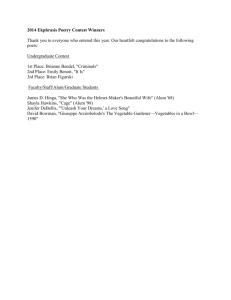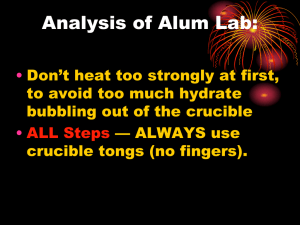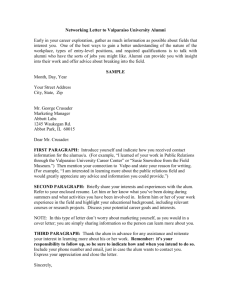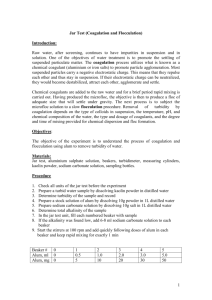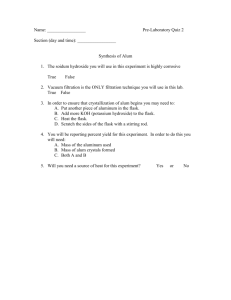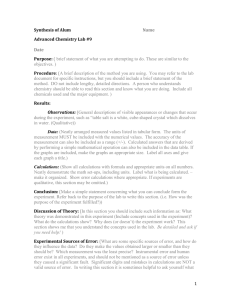Research Journal of Environmental and Earth Sciences 5(3): 153-159, 2013
advertisement
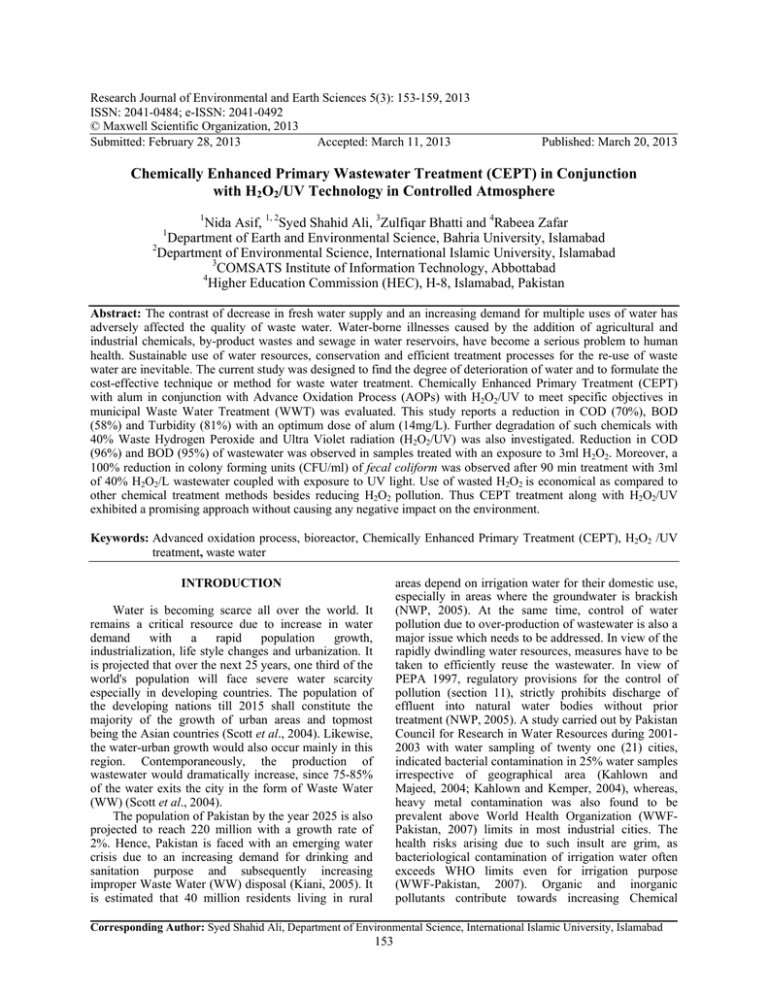
Research Journal of Environmental and Earth Sciences 5(3): 153-159, 2013 ISSN: 2041-0484; e-ISSN: 2041-0492 © Maxwell Scientific Organization, 2013 Submitted: February 28, 2013 Accepted: March 11, 2013 Published: March 20, 2013 Chemically Enhanced Primary Wastewater Treatment (CEPT) in Conjunction with H2O2/UV Technology in Controlled Atmosphere 1 Nida Asif, 1, 2Syed Shahid Ali, 3Zulfiqar Bhatti and 4Rabeea Zafar Department of Earth and Environmental Science, Bahria University, Islamabad 2 Department of Environmental Science, International Islamic University, Islamabad 3 COMSATS Institute of Information Technology, Abbottabad 4 Higher Education Commission (HEC), H-8, Islamabad, Pakistan 1 Abstract: The contrast of decrease in fresh water supply and an increasing demand for multiple uses of water has adversely affected the quality of waste water. Water-borne illnesses caused by the addition of agricultural and industrial chemicals, by-product wastes and sewage in water reservoirs, have become a serious problem to human health. Sustainable use of water resources, conservation and efficient treatment processes for the re-use of waste water are inevitable. The current study was designed to find the degree of deterioration of water and to formulate the cost-effective technique or method for waste water treatment. Chemically Enhanced Primary Treatment (CEPT) with alum in conjunction with Advance Oxidation Process (AOPs) with H2O2/UV to meet specific objectives in municipal Waste Water Treatment (WWT) was evaluated. This study reports a reduction in COD (70%), BOD (58%) and Turbidity (81%) with an optimum dose of alum (14mg/L). Further degradation of such chemicals with 40% Waste Hydrogen Peroxide and Ultra Violet radiation (H2O2/UV) was also investigated. Reduction in COD (96%) and BOD (95%) of wastewater was observed in samples treated with an exposure to 3ml H2O2. Moreover, a 100% reduction in colony forming units (CFU/ml) of fecal coliform was observed after 90 min treatment with 3ml of 40% H2O2/L wastewater coupled with exposure to UV light. Use of wasted H2O2 is economical as compared to other chemical treatment methods besides reducing H2O2 pollution. Thus CEPT treatment along with H2O2/UV exhibited a promising approach without causing any negative impact on the environment. Keywords: Advanced oxidation process, bioreactor, Chemically Enhanced Primary Treatment (CEPT), H2O2 /UV treatment, waste water areas depend on irrigation water for their domestic use, especially in areas where the groundwater is brackish (NWP, 2005). At the same time, control of water pollution due to over-production of wastewater is also a major issue which needs to be addressed. In view of the rapidly dwindling water resources, measures have to be taken to efficiently reuse the wastewater. In view of PEPA 1997, regulatory provisions for the control of pollution (section 11), strictly prohibits discharge of effluent into natural water bodies without prior treatment (NWP, 2005). A study carried out by Pakistan Council for Research in Water Resources during 20012003 with water sampling of twenty one (21) cities, indicated bacterial contamination in 25% water samples irrespective of geographical area (Kahlown and Majeed, 2004; Kahlown and Kemper, 2004), whereas, heavy metal contamination was also found to be prevalent above World Health Organization (WWFPakistan, 2007) limits in most industrial cities. The health risks arising due to such insult are grim, as bacteriological contamination of irrigation water often exceeds WHO limits even for irrigation purpose (WWF-Pakistan, 2007). Organic and inorganic pollutants contribute towards increasing Chemical INTRODUCTION Water is becoming scarce all over the world. It remains a critical resource due to increase in water demand with a rapid population growth, industrialization, life style changes and urbanization. It is projected that over the next 25 years, one third of the world's population will face severe water scarcity especially in developing countries. The population of the developing nations till 2015 shall constitute the majority of the growth of urban areas and topmost being the Asian countries (Scott et al., 2004). Likewise, the water-urban growth would also occur mainly in this region. Contemporaneously, the production of wastewater would dramatically increase, since 75-85% of the water exits the city in the form of Waste Water (WW) (Scott et al., 2004). The population of Pakistan by the year 2025 is also projected to reach 220 million with a growth rate of 2%. Hence, Pakistan is faced with an emerging water crisis due to an increasing demand for drinking and sanitation purpose and subsequently increasing improper Waste Water (WW) disposal (Kiani, 2005). It is estimated that 40 million residents living in rural Corresponding Author: Syed Shahid Ali, Department of Environmental Science, International Islamic University, Islamabad 153 Res. J. Environ. Earth Sci., 5(3): 153-159, 2013 Oxygen Demand (COD) and Biological Oxygen Demand (BOD) in waste water, thus such a situation demands treatment of waste water with safer chemical treatments in conjunction with conventional methods. Advanced Oxidation Processes (AOP) provides an efficient and promising alternative to conventional technique and could also be used in combination with the conventional methods, increasing the overall performance of wastewater treatment (US-EPA, 2000). Various studies have shown that AOPs can be utilized for breaking down persistent insecticides, dyes, surfactants and organo-chlorine compounds into relatively harmless substances (Pelezetti and Schiavello, 1991; Fox and Dulay, 1993; Linsebigler et al., 1995; Yonar et al., 2006). It has been reported that conventional treatment with alum prior to advanced oxidation process may further improve quality of waste water (Velasco et al., 2007). The effect of using aluminium sulphate and Poly Aluminium Chloride (PACl) as a coagulant for the removal of dissolved organic carbon of surface waters has been reported with the efficiency of alum remained highly dependant on pH during the process (Velasco et al., 2007). A combination of alum and aluminium hydroxide have also been reported for efficient removal of phosphates from WW, a major contributors to the eutrophication of water reservoirs (Georgantas and Grigoropoulou, 2007). Ksibi (2006) reported reduction of orthophosphate and metaphosphate with an optimum pH of 5-6 to treat domestic WW in Tunisia along with hydrogen peroxide. Hydrogen peroxide increased the biodegradability of the water sample and an optimum dose of 1.5 ml/L was sufficient to destroy majority of the risks even though it may vary according to the amount of organic matter present in water (Yonar et al., 2006; Ksibi, 2006). In addition to H2O2, UV treatment has also been used for wastewater treatment, alone or in combination or in combination with other chemicals (Mahvi et al., 2012; Yonar et al., 2006) Abbottabad, a city in Northern Province (KPK), cater to a large number of boarding schools and other educational institutions and amount of waste water go unchecked in drains and nullahs, that is later used for irrigation purpose without any prior treatment. Therefore, the objectives of the study were: to find the optimum dosage of conventional alum treatment of wastewater originating from domestic consumers of Abbottabad city and to bring chemical and microbial parameters to an acceptable limit by employing Chemically Enhanced Primary Treatment (CEPT) along with H2O2/UV for reducing microbial load. MATERIALS AND METHODS Material: Wastewater sample collection: Wastewater samples were collected in sterile polystyrene containers from Sheikh-ul-Bandi, near Kalapul, Abbottabad, KPK. Sample collection bottles were rinsed with sample thrice before filling it and then corked tightly and taken Fig. 1: Experimental Design for Alum treatment and UASB Reactor for Wastewater Treatment to the laboratory in icebox for analysis or stored at 4°C till further treatment and analysis (APHA, 2005). Experimental setup: For the determination of optimum dose of alum for the pre-treatment of waste water samples and subsequent treatment using AOPs, the experiment was carried out at the ambient room temperature (25°C). A mixing apparatus was devised (UASB Bioreactor) and used with a rotational speed set at about 480 rpm (Fig. 1). Whereas, microbial analysis of waste water samples was carried out under Laminar flow-hood. Chemical treatment: For pre-treatment, alum (Al2 (SO4)3.16H2O) (Merck Inc.) was used. In order to obtain an optimum dosage for attaining maximum reduction in turbidity, BOD, COD etc. an appropriate amount of alum was determined by using different concentrations of alum (10, 12, 14, 16 mg/L). One liter of WW was dosed at varying concentrations of the coagulant, at its natural pH (7.5 to 8). After the determination of optimum alum dose, i.e., 14 mg of alum per liter of domestic wastewater sample, the supernatant was removed and further treated with H2O2/UV treatment, where 30-40% waste H2O2 was used. Material for photochemical treatment: UASB bioreactor was employed for photochemical treatment. For UV treatment, a mercury lamp of 18 Watts was employed and the optimum H2O2 concentration used was 3 mg/L. The contents of the wastewater was continuously mixed with the help of a mixer at 480 rpm and the water samples were withdrawn and analyzed after a time interval of 30, 60 and 90 min (Fig. 1) (Georgantas and Grigoropoulou, 2007) Methods: Determination of pH, turbidity, TDS and EC: All physicochemical parameters, i.e., pH (Hanna Instruments, USA), turbidity, salt concentration, Total Dissolable Solids (TDS) and Electrical Conductivity (EC), were measured either on site or in the laboratory by using APHA Standard Methods, 2005. Determination of Chemical Oxygen Demand (COD): Chemical oxygen demand is defined as the amount of a 154 Res. J. Environ. Earth Sci., 5(3): 153-159, 2013 specified oxidant that reacts with the sample under controlled conditions. The quantity of oxidant consumed is expressed in terms of its oxygen equivalence (Eaton, 2005). In order to determine the COD, a suitable volume of sample and reagents were transferred into a test tube containing 2.5 ml sample; 1.5 ml digestion solution and 3.5 ml sulfuric acid reagent. After mixing, the sample was digested and cooled. Treatment test tube along with a blank and one standard tubes were placed in block digester at 150°C for 2 h and was brought to room temperature (APHA, 2005; Eaton, 2005). Determination of Biochemical Oxygen Demand(BOD): An estimate of the oxygen consumed in the unit volume of water over a period of time is called Biochemical Oxygen Demand (BOD) (Tripathi and Govil, 2001). According to the APHA (2005), method 10 ml water sample was diluted with 250 ml distilled water followed by addition of 1 ml each of phosphate buffer (to maintain pH) MgSO4, CaCl2, FeCl3 (to provide nutrition to microbes). The solution was poured in two BOD bottles for BOD incubation for 5 days at 20°C in dark and Dissoluble Oxygen (DO) readings were calculated as BOD by Eq. (1): BOD (mg/L) = D1 - D2 / P (1) where, D1 = DO (Dissolved Oxygen) in initial sample (mg/L) D2 = DO (Dissolved Oxygen) in incubated sample (mg/L) P = Dilution factor Microbial analysis of waste water (pre- and posttreatment): The membrane filtration technique along with Most Probable Number (MPN) of bacteria, has been proposed as most effective technique for testing fluid samples for microbiological contamination (APHA, 1995, 2005). It involves less preparation and provides microbial presence or absence information within 24 h. Sample was collected and necessary dilutions were made before assay on nutrient culture media i.e., EMB (Eosin Methylene Blue). A colony counter with magnification (10-15X) was used to count presence of microbes after incubation at 32°C for 48 h (APHA, 2005). RESULTS AND DISCUSSION Physico-chemical analysis of untreated wastewater samples: According to the results, pH of untreated waste water samples was recorded in the range of 6.805-8.930 with a mean value of 8.035. The TDS was found below NEQs standards and salt concentration Table 1: Physico-Chemical Analysis of Waste Water Samples Parameters Conc. NEQS Standards Turbidity 133 NTU Not available Conductivity 1192.5 µS Not available %Salt 2.2 Not available TDS 595 mg/L 3500 mg/L pH 8.035 6 to 9 BOD 202.5 mg/L 80 mg/L COD 308 mg/L 120 mg/L was 2.2% (Table 1). On the other hand, the COD, BOD5 and turbidity values of untreated waste water sample were found 2-3 times above NEQs limits (Table 1). It was therefore, concluded that the collected water sample needed to be treated before allowing it to enter into river, stream etc. to meet the NEQs regulations. Effect of alum dosing on wastewater sample: Effect on pH: According to the methods, alum reacts with carbonates and/or hydroxyl species therefore help to remove bases from solution, however make the solution more acidic. It is therefore reported that during high turbidity and subsequent alum dosing, the water’s pH is likely to drop to less than 4 (Bhar et al., 2005). Upon its addition to water, calcium and magnesium bicarbonate alkalinity reacts with the alum to form an insoluble aluminum hydroxide precipitate (US-EPA, 2000). Owing to this acidic nature of alum, its addition slightly lowered the pH. Based on the results, the pH of untreated WW samples was reduced from 8 (raw water sample before alum dosing) to about 7 after the addition of 16 mg/L of alum. Effect on turbidity: In addition to drop in pH, the basic purpose for the addition of alum was to form flocs and to reduce particulate matter so that disinfection process through UV treatment could be effective. Disinfection by UV is ineffective if pathogens are within particulates or if there is too much organic material left in the water. Thus, the effective removal of flocs is critically important for a successful Wastewater Treatment Plant (WTP) (Bhar et al., 2005). CEPT using alum greatly reduced the turbidity of the WW samples with an addition of only 8 ml/L of alum reduced the turbidity by 52.88 %. As evident, subsequent increase in alum dose increased the removal of turbidity to 81.33% with an alum concentration of 16 mg/L (Fig. 2). Effect on COD: A significant reduction in the COD of the WW samples was recorded after alum treartment (Fig. 3). The COD was reduced from 308 mg/L (Table 1) to 90 mg/L with a maximum percentage reduction (71%) recorded with 14 mg/L alum (Fig. 3). However, with further increase in alum concentration (16 mg/L of alum) did not show any significant reduction in COD and was found above NEQs Standards (Fig. 3). It was therefore postulated that 155 Res. J. Environ. Earth Sci., 5(3): 153-159, 2013 Turbidity 70 60 Turbidity NTU 50 40 Turbidity 30 20 10 0 0 5 10 15 20 Alum dose m g/L Fig. 2: Relationship of turbidity reduction and alum dose COD Reduction mg/L COD 350 COD 300 250 200 150 100 50 0 0 5 10 15 20 Alum Dose mg/L Fig. 3: COD removal using alum at various dosage concentrations BOD 120 BOD mg/L 100 80 60 BOD 40 20 0 0 5 10 15 20 Alum dose m g/L Fig. 4: BOD reduction after Alum Treatment between 13-15 mg/L alum could be useful in removing 70% turbidity in wastewater, a pre-cursor for microbial growth. Such a situation necessitates additional treatment, i.e., UV treatment, as proposed previously (Mahavi et al., 2012). Effect on BOD: The BOD reduction at 10 mg/L was recorded from 202 mg/L to 102 mg/L (50% reduction) (Table 1; Fig. 4). Henceforth, increasing the alum dosage to 12 mg/L, 14 mg/L and 16 mg/L, the BOD values were decreased to 97.33 mg/L (51.93%), 95.66 mg/L (52.75%), 84.66 mg/L (58.18%), respectively, however it was not found significantly different (Fig. 4). It was previously reported that chemical treatment with different chemicals including alum reduced BOD (Koivunen and Heinonen-Tanski, 2005). Since, the BOD of the WW after alum treatment was still high, so in order to be safely discharged into the environment, further treatment was deemed necessary. Further reduction was aimed to be reached with combining UV treatment along alum pre-treatment and discussed in next section. Effect on Microbial Growth: Small reduction in the microbial count was observed (Table 2). It may be attributed to the fact that with the settling down of 156 Res. J. Environ. Earth Sci., 5(3): 153-159, 2013 Table 2: Effect of Alum on microbial growth Microbial count of domestic waste water sample after alum treatment -------------------------------------------------------------------------------------------------------------------------------------------------------------------------------Dilutions Control water sample Water sample A Water sample B Water sample C Water sample D Water sample E TNTC TNTC TNTC TNTC TNTC TNTC 10-1 10-2 TNTC TNTC TNTC TNTC TNTC TNTC -3 10 TNTC TNTC TNTC TNTC TNTC TNTC -4 10 TNTC TNTC 200 211 90 201 10-5 TNTC 250 21 36 5 16 Control water sample: without any alum; TNTC: Too Numerous To Count; Water sample A: WW with 8 mg/L alum; Water sample B: WW with 10 mg/L alum; Water sample C: WW with 12 mg/L alum; Water sample D: WW with 14 mg/L alum; Water sample E: WW with 16 mg/L alum Fig. 5: Effects of H2O2 /UV on turbidity with respect to time Fig. 6: COD removal after H2O2 /UV Treatment dissolved and suspended particles, the niches for the growth of bacteria were also recessed. In addition, the acidic property of alum also hindered their growth, hence, the decrease in microbial count. The microbial population reduction was, however only evident after a 10-4 and 10-5 dilution of the water sample. The raw water sample, without any alum treatment, showed uncountable colony growth even at this dilution level. With the increase in alum dose, the microbial growth also decreased (Table 2). Effect of H2O2 /UV treatment on the wastewater characteristics: Effect on pH: The change in pH with respect to time was inconsequential. Only a slight increase in pH was observed which may be due to the oxidation of organic dissolved solids in effluent. The pH changed from about 7.4 to about 7.8 after 90 min of H2O2 /UV. Effect on Turbidity: H2O2 /UV treatment enhances the oxidation of metal complexes and improve the activity of inorganic flocculants. Initially, an increase in turbidity was observed, that may be due to the mixing of the WW samples. The turbidity increased to 53 NTU, after the 30 min treatment, whereas, after 60 min and 90 min, the turbidity was reduced to 50 NTU and 48 NTU, respectively (Fig. 5). Effects on COD: H2O2 is one of the most powerful oxidizers known and results in the formation of hydroxyl radicals (OH), which react with the pollutants such as iron, sulfides, solvents, gasoline as well as pesticides present in water, thus, reducing the contamination level in water (Richard, 1991). The UV radiation provides the necessary energy for carrying the various chemical, physical and biological processes for the oxidizing or reducing the pollutants present. These oxidations entail an array of direct and indirect 157 Res. J. Environ. Earth Sci., 5(3): 153-159, 2013 Fig. 7: Reduction of BOD by using H2O2 /UV treatment Table 3: Bacterial inactivation after Ww sample Dilutions After 30 min 10-1 4 CFU/10 ml -2 10 1 CFU/10 ml 0 CFU/10 ml 10-3 0 CFU/10 ml 10-4 0 CFU/10 ml 10-5 H2O2 /UV Treatment of domestic After 60 min 2 CFU/10 ml 0 CFU/10 ml 0 CFU/10 ml 0 CFU/10 ml 0 CFU/10 ml After 90 min 0 CFU/10 ml 0 CFU/10 ml 0 CFU/10 ml 0 CFU/10 ml 0 CFU/10 ml Table 4: Comparison and overall efficiency of the treatment process used Initial Alum H2O2/UV values treatment Reductio treatment Reduct Parameters (mg/L) (mg/L) n (%) (mg/L) ion (%) COD(mg/L) 308 91.33 70.34 11 96.42 BOD(mg/L) 202.5 84.66 58.18 9 95.55 Turbidity (NTU) 133 NTU 52.66 NTU 80.33% 48 NTU 63.9 photoreactions which are initiated by the absorbed UV radiation. As a result of H2O2 /UV treatment, there was a further decrease in the COD of the water sample, which fell to 11 mg/L after 90 min treatment. This represents an overall 96% reduction. After 30 min, the COD was measured to be 40 mg/L and after 60 min, 23 mg/L (Fig. 6). Effect on BOD: The reduction in BOD was profound with about 80% reduction, just after 30 min (Fig. 7). After 90 min, it was reduced to 9 mg/L, showing 95% reduction. Direct photolysis of the hydrogen peroxide with UV radiation gives hydroxyl (OH) radicals. Hydroxyl radicals further react rapidly with several of the organic contaminants present in Ww, by abstracting hydrogen atoms or by addition to aromatic systems and double bonds (Richard, 1991). Effect on Microbial Growth: Using primary and secondary wastewater treatment processes alone may result in 90-99.9% elimination and tertiary treatment may further decimate these micro-organisms (90-99%), however, the treated wastewaters could still be contaminated by high microbial numbers. Henceforth, further disinfection of this treated WW maybe necessary. For this purpose, H2O2/UV process was used. According to previous studies, H2O2 is thought to first attack microbial cell walls, membranes and enzymatic or transport systems and as a result, the microbial repair mechanisms, required to repair minor damage, may become overloaded, leading to their inability to repair the injuries and result in subsequent death (Koivunen and Heinonen-Tanski, 2005). Hence, the most significant effect was observed in the inactivation of fecal coliform, which fell to 0 CFU/10 ml after 90 min of H2O2 /UV treatment. Even after 30 min, the microbial count had fallen to 4 CFU/10 ml of WW sample, while after 60 min, it had fallen to 2 CFU/10 ml (Table 3). Whereas, the overall efficiency of treatment processes is summarized in Table 4. Based on current findings, H2O2/UV combination along with pre-treatment by alum, has proved successful in treating domestic as well as industrial waste-water. Further use and reuse of treated WW for agricultural irrigation is recommended. Recently, in a similar study has also confirmed the efficacy and treatment with H2O2/UV combination (Mahvi et al., 2012) CONCLUSION An exponential increase in population, rapid industrialization and subsequently, the dilemma of water shortages has been seriously threatening environment and human health in developing countries. For the sustainable use of water resources and its conservation, efficient treatment processes for the reuse of waste water are inevitable. The proposed Wastewater treatment process uses the waste H2O2, which was obtained from Shezan Industries and is produced during the sterilization of juice packaging. This waste H2O2 was utilized for the treatment of wastewater, which would otherwise discharged into the drains and hence, wasted and could even contribute to further pollution of the water. Use of AOP's for the treatment of WW allows the degradation of a number of organic and inorganic pollutants into reducible species, or other harmless compounds such as carbon dioxide and water. No harmful by-products are obtained and hence, it is an imperative process in Green Chemistry for sustaining our environment. Furthermore, when used in conjugation with chemically enhanced primary treatment (CEPT), H2O2/UV treatment of domestic waste water, using 3 mL of 40% waste H2O2/L of WW, 158 Res. J. Environ. Earth Sci., 5(3): 153-159, 2013 resulted in 100% inactivation of fecal coliform and 96% and 95% reduction in COD and BOD, respectively. Pure H2O2 is used conventionally, whereby the use of waste hydrogen peroxide is far more economical, without compromising the efficacy of the associated treatment technique. REFERENCES APHA, 1995. Microbiological Testing of Potable Water by US-EPA In: Standard Methods for the Examination of Water and Wastewater. 11th Edn., Washington D.C., USA. APHA,2005.Standard Methods for the Examination of Water&Wastewater.21stEdnWashingtonD.C., USA Bhar, S., C. Boone, P. Lastra, L. Mar, B. Rahm and J. Romero, 2005. Water purification in Honduras. Cornell Chronicle, 37(2): 6. Eaton, A.D., 2005. Standard Methods for the Examination of Water and Wastewater, 21st Edn., American Public Health Association, American. Fox, M.A. and M.T. Dulay, 1993. Heterogeneous photocatalyst. Chem. Rev., 93: 341-358. Georgantas, D.A. and H.P. Grigoropoulou, 2007. Orthophosphate and metaphosphate ion removal from aqueous solution using alum and aluminum hydroxide. J. Colloid Interface Sci., 315: 70-79. Kahlown, M.A. and A. Majeed, 2004. Pakistan water resources development and management. PCRWR Report, 2004. Kahlown, M.A. and W.D. Kemper, 2004. Reducing conveyance losses from water channels. A Report for PCRWR, 2004. Kiani, K., 2005. National Water Policy: Draft Water Policy Placed before Cabinet. (DAWN Group of Newspapers (Pakistan). Koivunen, J. and H. Heinonen-Tanski, 2005. Inactivation of enteric microorganisms with chemical disinfectants, UV irradiation and combined chemical/UV treatments. Water Res., 39: 1519-1526. Ksibi, M., 2006. Chemical oxidation with hydrogen peroxide for domestic wastewater treatment in Tunisia. Chem. Eng. J., 119: 161-165. Linsebigler, A., G. Lu and J.T. Yates, 1995. Photocatalysis on tion surfaces: Principles, mechanisms and selected results. J. Chem. Rev., 95: 735-758. Mahvi, A.H., H. Akbari, K. Hozhabri, F.K. Mostafapour, M. Khamarnia and A.R. Khorshid, 2012. Application of UV/H2O2 process for enhancement Of industrial wastewater biodegradability. Fresen. Environ. Bull., 21(4a): 1015-1021. NWP, 2005. National Water Policy, Pakistan, Ministry of Water and Power Development, Govt. of Pakistan, Islamabad. Pelezetti, E. and M. Schiavello, 1991. Photochemical Conversion and Storage of Solar Energy. Kluwer Academic Publisher, USA. Richard, G.Z., 1991. Potential applications of concentrated solar energy, Proceedings of a Workshop: Water Treatment: Advanced Photooxidation Processes, U.S. Environmental Protection Agency. Scott, C., N. Faruqui and L. Rachid-Sally, 2004. Wastewater Use in Irrigated Agriculture: Confronting the Livelihood and Environmental Realities. Published by CAB International in Association with International Water Management Institute and International Development Research Center, Wallingford, UK. Tripathi, B.D. and S.R. Govil, 2001. Water Pollution (An Experimental Approach), Department of Botany Banaras Hindu University. 1st Edn., Published by S.K. Jain for CBS Publishers and Distributors, India. US-EPA, 2000. Wastewater Technology Fact Sheet: Chemical Precipitation Methods. Washington D.C., USA. Velasco, U.I., J.I. Álvarez-Uriarte and J.R. GonzálezVelasco, 2007. Enhanced coagulation under changing alkalinity-hardness conditions and its implications on trihalomethane precursors removal and relationship with UV absorbance. Sep. Purif. Technol., 55: 368-380. WWF-Pakistan, 2007. Water at Risk: Water and Health Related Issues in Pakistan and Key Recommendations. Freshwater and Toxics Program, WWF - Pakistan. Yonar, T., K. Kestioglu and N. Azbar, 2006. Treatability Studies on domestic waste water using UV/H2O2 process. Appl. Catal. B-Environ., 67: 223-228. 159
